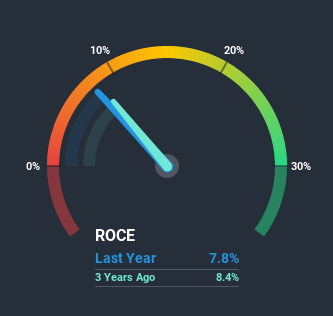Tootsie Roll Industries (NYSE:TR) Could Be At Risk Of Shrinking As A Company
If you're looking at a mature business that's past the growth phase, what are some of the underlying trends that pop up? Typically, we'll see the trend of both return on capital employed (ROCE) declining and this usually coincides with a decreasing amount of capital employed. This reveals that the company isn't compounding shareholder wealth because returns are falling and its net asset base is shrinking. In light of that, from a first glance at Tootsie Roll Industries (NYSE:TR), we've spotted some signs that it could be struggling, so let's investigate.
What is Return On Capital Employed (ROCE)?
For those who don't know, ROCE is a measure of a company's yearly pre-tax profit (its return), relative to the capital employed in the business. To calculate this metric for Tootsie Roll Industries, this is the formula:
Return on Capital Employed = Earnings Before Interest and Tax (EBIT) ÷ (Total Assets - Current Liabilities)
0.078 = US$72m ÷ (US$985m - US$70m) (Based on the trailing twelve months to December 2020).
Therefore, Tootsie Roll Industries has an ROCE of 7.8%. On its own that's a low return on capital but it's in line with the industry's average returns of 8.4%.
See our latest analysis for Tootsie Roll Industries
Historical performance is a great place to start when researching a stock so above you can see the gauge for Tootsie Roll Industries' ROCE against it's prior returns. If you'd like to look at how Tootsie Roll Industries has performed in the past in other metrics, you can view this free graph of past earnings, revenue and cash flow.
What Does the ROCE Trend For Tootsie Roll Industries Tell Us?
There is reason to be cautious about Tootsie Roll Industries, given the returns are trending downwards. To be more specific, the ROCE was 11% five years ago, but since then it has dropped noticeably. And on the capital employed front, the business is utilizing roughly the same amount of capital as it was back then. Since returns are falling and the business has the same amount of assets employed, this can suggest it's a mature business that hasn't had much growth in the last five years. If these trends continue, we wouldn't expect Tootsie Roll Industries to turn into a multi-bagger.
The Bottom Line
In summary, it's unfortunate that Tootsie Roll Industries is generating lower returns from the same amount of capital. In spite of that, the stock has delivered a 14% return to shareholders who held over the last five years. Regardless, we don't like the trends as they are and if they persist, we think you might find better investments elsewhere.
Since virtually every company faces some risks, it's worth knowing what they are, and we've spotted 2 warning signs for Tootsie Roll Industries (of which 1 is a bit unpleasant!) that you should know about.
While Tootsie Roll Industries may not currently earn the highest returns, we've compiled a list of companies that currently earn more than 25% return on equity. Check out this free list here.
This article by Simply Wall St is general in nature. It does not constitute a recommendation to buy or sell any stock, and does not take account of your objectives, or your financial situation. We aim to bring you long-term focused analysis driven by fundamental data. Note that our analysis may not factor in the latest price-sensitive company announcements or qualitative material. Simply Wall St has no position in any stocks mentioned.
Have feedback on this article? Concerned about the content? Get in touch with us directly. Alternatively, email editorial-team (at) simplywallst.com.

